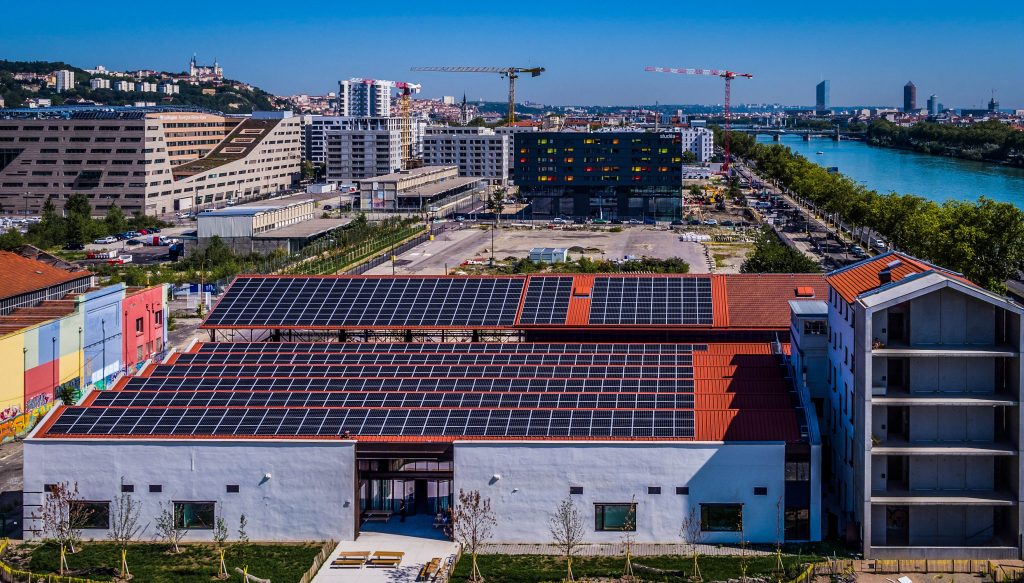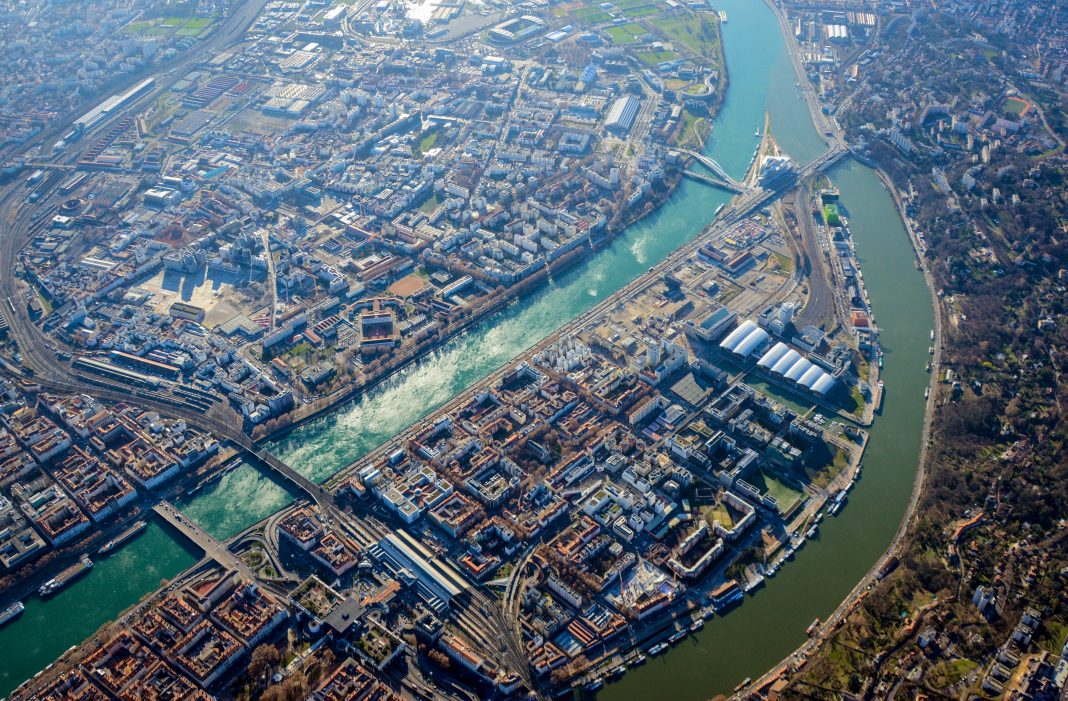SPL Lyon Confluence is carrying out a stand-out urban renewal project in a once-deprived district of central Lyon. Project Manager Etienne Vignali describes how this offers a significantly chance to undertake a large-scale decarbonisation masterplan in an area packed full of social, private, and public properties, and how they have overcome the challenge of retrofitting protected heritage buildings.
Etienne Vignali describes how central Lyon faced degradation after the 1980s as industrial activity declined and moved to the suburbs. One of Europe’s busiest motorways bisected the city, entrenching the problem. Few wanted to live in the socially deprived neighbourhoods, where undesirable but essential facilities were concentrated: the prison, harbour and logistics hubs, gas factory, train depot, and the wholesale market.
Ignoring the problem would have been negligent; this created a strong political will to regenerate the area. In 1999, Métropole de Lyon and the City of Lyon formed SPL Lyon Confluence to redevelop a 150-hectare (1 million m2) district. Within 30 years, this project will double the size of the city centre.
A Public-Private Partnership
Etienne is a Project Manager at the SPL Lyon Confluence. He tells us that ‘SPL’ literally translated as “Local Public Society”. This is a unique type of French private company but for which only the public authorities are shareholders – in this case, the municipality (City of Lyon) and the Greater Lyon authority. This one is funded by a feeder grant from Horizon 2020 and a mix of City money, income from selling land, and funding from additional calls for projects such those supporting innovations by the European Commission.
Operationally, the Confluence gives tailored support to development projects, from early-stage feasibility studies and help with decisions to assistance with sourcing permits, funding, and architect and construction companies.
“Our core assignment is to do the master plan, macro studies, and surveys,” Etienne details. The City caries out checks and balances, then SPL Lyon Confluence sells ringfenced land to a real estate developer, who builds and sells properties on to approved owners or investors. But it’s not simply an open auction with wins for the highest bidder; there’s a minimum payment threshold. Compulsory requirements safeguard the quality of the urban development. These guidelines are “much more demanding than the French regulation”, Etienne explains, regarding the environmental and energy performance of the buildings. This makes Lyon a shining star in France’s decarbonisation movement.
Progress Report
Sitting outside the city administration gives the SPL a specific advantage. Operating as what Etienne describes as “a ‘satellite’ of the city”, being a small size organisation gives it flexibility and enables ‘fast-paced decision-making’.
“The governance ‘in between’ public and private status, and a business model not based only on public subsidies, gives an incentive to develop new services of general interest, such as building energy retrofit, the operation of renewable energy infrastructures, the management of energy communities, urban data collection and analysis, etc.”
Residences in the Confluence range from social housing blocks with a single owner to blocks of condominiums containing multiple individually owned dwellings. It is also the site of “former industrial and logistics activity” and public facilities, like a concert hall, school, gym, or offices.

By summer of 2022, 600,000 m2 out of a planned 1 million m2 newly constructed high environmental performance buildings were complete.
In addition, twenty buildings in the historic part of the Lyon Confluence area were fully or nearly completely renovated to become low-energy (old) buildings, totally around 70,000 m2.
This ranges from a 1,500 m2 office space to a 15,000 m2 social housing block. Half are offices or municipal facilities and, of the 600 completed residential dwellings, two thirds are dedicated social housing.
As with many pioneering transformation projects, learning on the go has also informed and sped up the process. Etienne explains that 50,000 out of that 70,000 m2 was achieved in the second half of the last 10 years.
Save Time & Money: Combine Retrofitting with Renovations
At an early stage, SPL Lyon Confluence decided to retrofit all types and uses of buildings to “target quite ambitious levels of energy reduction”.
However, as Etienne proclaims, the bigger the energy makeover, the higher the cost.
“Several times we transform a former industrial or logistic building into a complete different use such as school, or into a concert hall,” Etienne reports.
Public buildings present a particular challenge. They often require extensive, costly renovations to change their operational function, not only an energy retrofit.
That’s why SPL Lyon Confluence takes an approach that combines energy saving methods – installing low-consumption technology like water heaters – with increased efficiency measures. These include double glazing, inside or outside insulation, and integrating renewable energies such as on-site photovoltaic production (solar panels) or district heating systems powered by biomass. Coordinating multiple solutions at once is more complicated and takes longer, meaning fewer projects are completed in a short timeframe. But, in doing so, energy consumption has been halved or even quartered!
The insulation offers improved comfort for those using the buildings in both winter and summer.
Some of Lyon-Confluence’s landlords have taken a very proactive attitude towards the transition, carrying out energy retrofits with their general renovations and repairs – adding loft insulation when waterproofing the roof, for example. They’ve taken advantage of subsidies to offset the costs, predicting that retrofits may anyway become mandatory in a future where funding has dried up. Their theory: make use of the opportunities presented to preserve or improve the real estate value of their buildings.

Historic Buildings: Retrofitting Heritage Respectfully
Strict regulations guarantee energy efficiency is baked into the Confluence’s design stage. “That’s the first tool we use to improve on the performance of buildings,” Etienne notes.
It’s an effective strategy. Contracts setting out compulsory milestones – and the threat of being kicked off projects for noncompliance – prevent developers making promises they fail to keep.
While it’s fairly easy to incorporate high-quality energy efficiency into Lyon’s new buildings, older properties present a different challenge. “Half the territory is historic neighbourhood,” our CityChanger tells us. Some of the social housing blocks in Lyon date back to the 1930s, when the city experienced a growth boom. Etienne points out that facades are protected in as Lyon-Confluence. This means that any energy retrofit needs to comply with local regulations that make their preservation mandatory.

Before image credit: SPL Lyon Confluence / Thierry Bazin 
After image credit: SPL Lyon Confluence / Laurence Danière
Stay Neutral, Build Trust, Create Change
In the early days, outspoken external forces were concerned that energy renovations would destroy the district’s character. Some reassurance came from SPL Lyon Confluence’s relative neutrality:
“An important characteristic is, we don’t have the power on everything. We are not the owner of the buildings; we are not the user of the building. We are the urban developer.”
With little to gain personally or politically, Etienne and his team can be seen as mediators, upholding standards for all sides in the drive for change.
When building owners struggle to access the authorisation that they need to get a development moving, SPL Lyon Confluence provides support. Their urban architect works with the local authority in charge of heritage protection to find solutions that could be a good balance between energy performance, cost, and heritage protection.
Etienne expands: “Depending on the types of buildings, solutions have sometimes been more complex to find than others. However, no building energy retrofit project has been stopped because of heritage protection. And all those that came to reality provide ‘real’ examples showing that we can combine heritage protection and low-energy building retrofit in a way that satisfies all stakeholders involved.”
It’s beneficial that the city department overseeing permits for heritage buildings and new construction are one and the same. Plus, the Confluence team’s experience with technical solutions, architectural compliance, energy savings, and cost control makes them well respected and knowledgeable on how to form a proposal that is likely to be approved.
Building trust for all parties involved helps the process move faster each time.
Easing the Change for Tenants in Situ
With the right management, heritage properties are not always the nightmare we imagine. But what about occupied buildings? How do we make fundamental changes to a building’s structure when people live in and use the internal spaces?
“It’s a big constraint on the work programme,” Etienne admits. A sense of understanding of the scale of disruption for the occupier, rather than focusing merely on the job at hand, goes a long way. As does communicating the project beforehand – and keeping it going.
He cites one example of a block of 150 homes where the social housing operator selected their construction company, among other criteria, on its ability to minimise the nuisance for inhabitants. The contractor was able to renew the heat and hot water supply, windows, and insulation in just 2-3 days per residence. The short timescale minimised disruption for residents. But, most importantly, our CityChanger adds, “The social housing operator also devoted some financial resources to have several people dealing with the tenants, to explain the project, to collect their complaints or their questions”.

Image credit: SPL Lyon Confluence / Jérémy Mathieu
A single representative set up office in the basement of the building. Every household had their contact number. They were the point of contact for both the tenants and the construction company; they alone dealt with every enquiry and grievance.
This way, residents didn’t need to interrupt and confront builders working on-site. It kept the work on schedule. It would have been impossible without this resource, Etienne believes.
Another problem the SPL Lyon Confluence faced but has successfully resolved is that of commitment.
No Such Thing as a Free Launch
In the early days, Lyon-Confluence aimed big! They wanted to implement as many retrofitting projects as possible. At first, they took advantage of a local scheme providing assistance to condominium owners. Supported by the City of Lyon, the Greater Lyon authority, and the French State, this offered free feasibility studies to garner maximum interest.
“It took years and years and effort and meetings late in the night to end up with nothing, not a single project on track.”
Valuable lesson learnt, Etienne realises: “Anyone is always interested in a free study, because it doesn’t cost anything for them. It would have been better to start with a smaller ambition. To just target a few groups of owners who were really motivated and to share the cost of the feasibility study.”
This they eventually did. Interest dropped but the level of follow-through improved. The important factor was that retrofits happened, and some is better than none. Plus, that influences others to take action:
“Starting with a few projects with very motivated people is the best proof we can have for the next ones.”

Retrofitting Heritage Districts in a Nutshell
SPL Lyon Confluence is a masterclass for tackling tricky issues in large-scale district decarbonisation. Etienne Vignali’s experiences serve as fine advice for any city facing a similar challenge:
- Have a neutral mediator that tenants, the City, construction firms, and citizens trust to take care of the work.
- One project is better than none! “Spend more time and energy in getting even a few projects done rather than working on big or larger strategies.”
- Weed out the timewasters by charging a nominal fee for feasibility studies and learn from these concrete results to fine tune the next project.
- Don’t fear tackling all kinds of buildings. Occupied and heritage properties don’t need to be a monster if handled with consideration.
You can learn more about the SPL Lyon Confluence development with their series of short videos (French with English subtitles). Head over to their website to hear multiple stakeholders share learnings and good practice from first-hand accounts.


